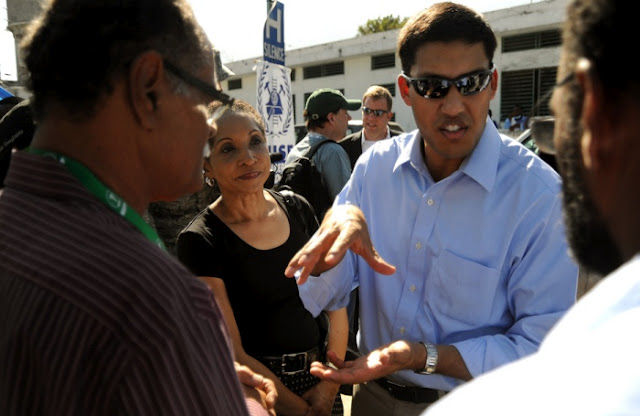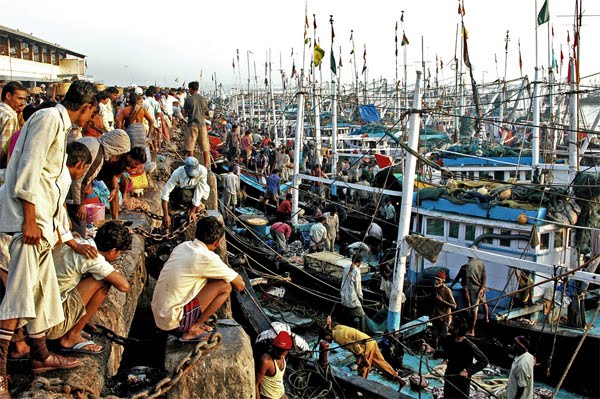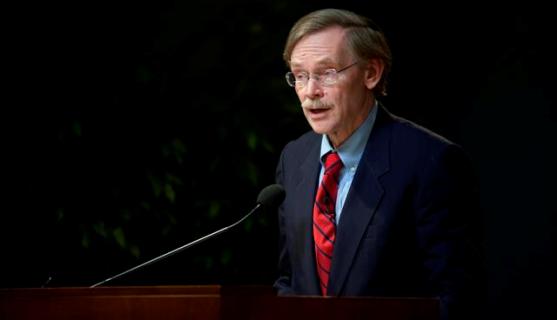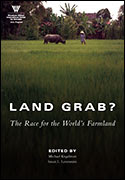Showing posts from category economics.
-
USAID’s Shah Focuses on Women, Innovation, Integration
›May 20, 2010 // By Wilson Center StaffWomen in developing countries are “core to success and failure” of USAID’s plan to fight hunger and poverty, and “we will be focusing on women in everything we do,” said USAID Administrator Rajiv Shah at today’s launch of the “Feed the Future” guide.
But to solve the “tough problem” of how to best serve women farmers, USAID needs to “take risks and be more entrepreneurial,” said Shah, as it implements the Global Hunger and Food Security Initiative.
“A lot of this is going to fail and that’s OK,” Shah said, calling for a “culture of experimentation” at the agency. He welcomed input from the private sector, which was represented at the launch by Des Moines-based Pioneer Hi-Bred.
In one “huge change in our assistance model,” Feed the Future will be “country-led and country-owned,” said Shah, who asked NGOs and USAID implementing partners to “align that expertise behind country priorities” and redirect money away from Washington towards “building real local capacity.” USAID will “work in partnership, not patronage,” with its 20 target countries, he said.
To insure that the administration’s agricultural development efforts are aligned to the same goals, Shah said USAID will collect baseline data from the start on three metrics: women’s incomes, child malnutrition, and agricultural production.
“Whether it is finance, land tenure, public extension, or training efforts, it does not matter whether it is an ‘agricultural development’ category of program,” said Shah. All programs will “provide targeted services to women farmers.”
While Shah briefly mentioned integrating these efforts with the administration’s Global Health Initiative, he only gave one example. Nutrition programs would be tied to health “platforms that already exist at scale” in country, such as HIV, malaria, vaccination, and breastfeeding promotion programs, he said.
Targeting Food Security: The Wilson Center’s Africa Program Takes Aim
If “food supplies in Africa cannot be assured, then Africa’s future remains dismal, no matter how efforts of conflict resolution pan out or how sustained international humanitarian assistance becomes,” says Steve McDonald, director of the Wilson Center’s Africa Program, in the current issue of the Wilson Center’s newsletter, Centerpoint. “It sounds sophomoric, but food is essential to population health and happiness—its very survival—but also to productivity and creativity.”
The May 2010 edition of Centerpoint highlights regional integration, a key focus of U.S. policy, as a mechanism for assuring greater continuity and availability of food supplies. Drawing on proceedings from the Africa Program’s “Promoting Regional Integration and Food Security in Africa” event held in March, Centerpoint accentuates key conclusions on building infrastructure and facilitating trade.
Photo Credit: “USAID Administrator Shah visits a hospital in Haiti” courtesy Flickr user USAID_Images. -
The Food Security Debate: From Malthus to Seinfeld
›Charles Kenny’s latest article, “Bomb Scare: The World Has a Lot of Problems; an Exploding Population Isn’t One of Them” reminds me of a late-night episode of Seinfeld: a re-run played for those who missed the original broadcast. Kenny does a nice job of filling Julian Simon’s shoes. What’s next? Will Jeffrey Sachs do a Paul Ehrlich impersonation? Oh, Lord, help me; I hope not.
I’ve already seen the finale. Not the one where Jerry, George, and Kramer go to jail — the denouement of the original “Simon and Ehrlich” show. After the public figured out that each successive argument (they never met to debate) over Malthus’s worldview was simply a rehash of the first — a statement of ideology, rather than policy — they flipped the channel.
Foreign Policy could avoid recycling this weary and irrelevant 200-year-old debate by instead exploring food security from the state-centric perspective with which policymakers are accustomed. While economists might hope for a seamless global grain production and food distribution system, it exists only on their graphs.
Cropland, water, farms, and markets are still part and parcel of the political economy of the nations in which they reside. Therefore they are subject to each state’s strategic interests, political considerations, local and regional economic forces, and historical and institutional inefficiencies.
From this realistic perspective, it is much less important that world population will soon surpass 7 billion people, and more relevant that nearly two dozen countries have dropped below established benchmarks of agricultural resource scarcity (less than 0.07 hectares of cropland per person, and/or less than 1000 cubic meters of renewable fresh water per person).
Today, 21 countries—with some 600 million people—have lost, for the foreseeable future (and perhaps forever), the potential to sustainably nourish most of their citizens using their own agricultural resources and reasonably affordable technological and energy inputs. Instead, these states must rely on trade with–and food aid from–a dwindling handful of surplus grain producers.
By 2025, another 15 countries will have joined their ranks as a result of population growth alone (according to the UN medium variant projection). By then, about 1.4 billion people will live in those 36 states—with or without climate change.
For the foreseeable future, poor countries will be dependent on an international grain market that has recently experienced unprecedented swings in volume and speculation-driven price volatility; or the incentive-numbing effects of food aid. As demand rises, the poorest states spend down foreign currency reserves to import staples, instead of using it to import technology and expertise to support their own economic development.
Meanwhile, wealthier countries finding themselves short of water and land either heavily subsidize local agriculture (e.g., Japan, Israel, and much of Europe) or invest in cropland elsewhere (e.g., China, India, and Saudi Arabia). And some grain exporters—like Thailand—decided it might be safer to hold onto some of their own grain to shield themselves from a future downturn in their own harvest. All of this is quite a bit more complex than either Malthus could have imagined or Kenny cares to relate.
It hardly matters why food prices spiked and remained relatively high—whether it is failed harvests, growing demand for grain-fed meat, biofuels, profit-taking by speculators, or climate change. Like it or not, each has become an input into those wiggly lines called grain price trends, and neither individual states nor the international system appears able or willing to do much about any of them.
From the state-centric perspective, hunger is sustained by:1. The state’s inability or lack of desire to maintain a secure environment for production and commerce within its borders;
In some countries, aspects of population age structure or population density could possibly affect all three. In others, population may have little effect at all.
2. Its incapacity to provide an economic and trade policy environment that keeps farming profitable, food markets adequately stocked and prices reasonably affordable (whether produce comes from domestic or foreign sources); and
3. Its unwillingness or inability to supplement the diets of its poor.
What bugs me most about Kenny’s re-run is its disconnect with current state-centric food policy concerns, research, and debates (even as the U.S. administration and Congress are focusing on food security, with a specific emphasis on improving the lives of women.—Ed.).
Another critique of Malthus’s 200-year-old thesis hardly informs serious policy discussions. Isn’t Foreign Policy supposed to be about today’s foreign policy?
Richard Cincotta is a consultant with the Environmental Change and Security Program and the demographer-in-residence at the H.L. Stimson Center in Washington, DC.
Photo Credit “The Bombay Armada” courtesy of Flickr user lecercle. -
Deepwater Horizon Prompts DOD Relief Efforts, Questions About Energy Security
›May 6, 2010 // By Schuyler NullAs the crippled Deepwater Horizon oil rig continues to spew an estimated 210,000 gallons of crude oil a day into the Gulf of Mexico, the Department of Defense has been asked to bring its considerable resources to bear on what has become an increasingly more common mission – disaster relief.
British Petroleum has requested specialized military imaging software and remote operating systems that are unavailable on the commercial market in order to help track and contain the spill.
In addition, the Coast Guard has been coordinating efforts to burn off oil collecting on the ocean’s surface and thousands of National Guard units have been ordered to the Gulf coast to help erect barriers in a bid to halt what President Obama called “a massive and potentially unprecedented environmental disaster,” as the oil slick creeps towards the coast.
As shown by these calls and the ongoing earthquake relief effort in Haiti, the military’s ability to respond to large-scale, catastrophic natural (and manmade) disasters is currently considered unmatched. The first Air National Guard aircraft was on the ground in Haiti 23 hours after the earthquake first struck, and DOD’s Transportation Command was able to begin supporting USAID relief efforts almost immediately. The Department of Defense also spearheaded American relief efforts after the 2004 tsunami and played a critical role in providing aid and security in New Orleans after Hurricane Katrina.
The Pentagon’s four-year strategic doctrine, the Quadrennial Defense Review (QDR), released earlier this year, predicts that such humanitarian missions will become a more common occurrence for America’s military, as the world grapples with the destabilizing effects of climate change, population growth, and competition over finite energy resources. Some experts see this expansion of the military’s portfolio as an essential part of a “hearts and minds” strategy, while others are critical of the military’s ability to navigate the difficulties of long-term reconstruction.
The QDR also highlights DOD’s efforts to reduce the need for oil – and thus deepwater oil rigs – in the first place.
The DOD as a whole is the largest consumer of energy in the United States, consuming a million gallons of petroleum every three days. In accordance with the QDR, Pentagon leaders have set an ambitious goal of procuring at least 25 percent of the military’s non-tactical energy requirement from renewable sources by 2025. The Air Force – by far the Pentagon’s largest consumer of petroleum – would like to acquire half of its domestic jet fuel requirement from alternative fuels by 2016 and successfully flight-tested a F/A-18 “Green Hornet” on Earth Day, using a blend of camelina oil and jet fuel.
At a speech at Andrews Air Force Base in March, President Obama lauded these efforts as key steps to moving beyond a petroleum-dependant economy. However, at the same event, he announced the expansion of off-shore drilling, in what some saw as a political bone thrown to conservatives. Since the Deepwater Horizon incident, the administration announced a temporary moratorium until the causes of the rig explosion and wellhead collapse have been investigated.
Cleo Paskal, associate fellow for the Energy, Environment, and Development Programme at Chatham House, warns that without paying adequate attention to the potential effects of a changing environment on energy infrastructure projects of the future – like the kind of off-shore drilling proposed for the Gulf and Eastern seaboard – such disasters may occur more frequently.
In an interview with ECSP last fall, Paskal pointed out that off-shore oil and gas platforms in the Gulf of Mexico were a prime example of how a changing environment – such as increased storm frequency and strength – can impact existing infrastructure. “Katrina and Rita destroyed over 400 platforms, as well as refining capacity onshore. That creates a global spike in energy prices apart from having to rebuild the infrastructure.”
The Department of Defense has demonstrated – in policy, with the QDR, and in action – that it can marshal its considerable resources in the service of renewable energy and disaster relief. But given the scope of today’s climate and energy challenges, it will take much more to solve these problems.
Photo Credit: “Deepwater Horizon,” courtesy of flickr user U.S. Coast Guard. U.S. Air Force Tech. Sgt. Joe Torba of the 910th Aircraft Maintenance Squadron, which specializes in aerial spray, prepares to dispatch aircraft to a Gulf staging area. -
Thinking Outside the (Lunch) Box: Meat and Family Planning
›May 3, 2010 // By Dan AsinJoel Cohen, a renowned population expert and professor at Columbia and Rockefeller universities, recently gave a lecture simply titled “Meat.” As it was co-sponsored by the International Food Policy Research Institute and the Population Reference Bureau, I was hoping for an insightful discussion of meat eating and its implications for feeding a world of nine billion. While I think Cohen avoided the question of whether meat eating is ultimately sustainable, I was pleased that he included two key insights: the potential for family planning services to contribute to food security, and the importance of using multidisciplinary approaches to solve today’s global problems.
Family Planning for Food Security
In working to improve food security, Cohen said policymakers and practitioners need to focus on those who are most vulnerable. To this end, he identified five groups and suggested targeted policies for each:
While the healthy eating policies will not surprise food security experts, his recommendations on family planning might. He highlighted what should be–but is not always–apparent: that tackling food security without thought for family planning is like attempting to fill an empty bucket without first plugging the holes.
Feeding the one billion hungry people in the world today is an enormous challenge that cannot be met by any single policy. Instead, it will take an array of partial solutions, and offering family planning services to women and young people is an important part of the package. Such projects can help reduce the number of children being born into hunger by allowing women and couples to assess their economic and food situations and plan according to their needs and wishes. Voluntary family planning services and materials will not solve the food security challenge on their own, but they can make it more manageable, especially in the long run.
Family planning’s potential contribution to food security is just one part of Cohen’s larger take-home message: population, economics, environment, and culture all interact. To meet today’s multidisciplinary challenges, single-sector approaches are not up to task.
The Many Faces of Meat
Cohen offered two competing perspectives on meat eating. On the one hand, average global meat production generates a fraction of the calories and protein, per unit of land, that could be derived from plant sources. It is likely the “largest sectoral source of water pollution,” said Cohen, and is at least partly responsible for the spread of over a dozen zoonotic diseases. It contributes to only 1.4 percent of world GDP while comprising 8 percent of world water consumption.
These hidden “virtual water” costs made headlines in Britain the other week, when a study on global water security published by the Royal Academy of Engineering popularized the Water Footprint Network’s earlier findings that that an average kilogram of beef requires 15,500 liters of water–over eight times the volume needed to produce the equivalent weight in soybeans and greater than 10 times that needed for the equivalent amount of wheat.
On the other hand, Cohen pointed out that meat production provides livelihoods for an estimated 987 million of the world’s rural poor, and has important cultural significance in many societies. And it can provide many essential nutrients, even in small doses.
In one study he cited, children living in Kenya who were provided 1 ounce of meat a day received 50 percent of their daily protein requirements and showed greater increases in physical activity and development, verbal and arithmetic test scores, and initiative and leadership behaviors as opposed to students who received the calorie-equivalent in milk or fat.
The Four Factors: Population, Economics, Environment, and Culture
Clearly, Cohen’s four factors all come in to play when evaluating meat’s role in food security. An analysis of any global health issue that looks at only one factor would miss indispensable parts of the problem.
“Population interacts with economics, environment, and culture,” Cohen concluded. “If you use that checklist when somebody gives you a simple-minded solution to a problem, you can save yourself a lot of simple-minded thinking.”
Photo: Pigs on a farm, courtesy Flickr user visionshare. -
Paul Collier Discusses the Plundering of the Planet at the World Bank
›April 27, 2010 // By Dan Asin “Nature is something that is both vulnerable and valued,” Paul Collier said yesterday at the World Bank. “It is being mismanaged…what it has turned into is a series of environmental battles between environmentalists and economists.”
“Nature is something that is both vulnerable and valued,” Paul Collier said yesterday at the World Bank. “It is being mismanaged…what it has turned into is a series of environmental battles between environmentalists and economists.”
Collier was giving the first public presentation of of his new book, The Plundered Planet: Why We Must—and How We Can—Manage Nature for Global Prosperity. In it, he asserts that disputes between environmentalists and economists often arise from a fundamental misunderstanding on both sides about the unique qualities and purposes of “natural assets.” This misunderstanding, he says, has created a state of natural plunder. In Plundered Planet, Collier elucidates the ethical and economic considerations for the proper management of natural assets, how a greater understanding of natural assets and better environmental management can be achieved, and lessons for development.
Paul Collier will be joining ECSP for an in-depth discussion of Plundered Planet, economics, and development at the Wilson Center in June. Until then, for a more detailed look, check out the New Security Beat’s previous coverage of Collier’s book preview with Nancy Birdsall, president of the Center for Global Development, at the U.S. Institute of Peace. -
World Bank President: Climate Policy Is Not “One-Size-Fits All”
› Speaking at the Woodrow Wilson Center yesterday, World Bank President Robert Zoellick said the financial crisis indicated that developed countries should listen to developing countries, but not out of “charity or solidarity: It is self-interest.”
Speaking at the Woodrow Wilson Center yesterday, World Bank President Robert Zoellick said the financial crisis indicated that developed countries should listen to developing countries, but not out of “charity or solidarity: It is self-interest.”
His prepared remarks, “The End of the Third World? Modernizing Multilateralism for a Multipolar World,” notably included a section on climate change:Take climate change: The danger is that we take a rule book from developed countries to impose a one-size-fits-all model on developing countries. And they will say no.
Climate change policy can be linked to development and win support from developing countries for low carbon growth but not if it is imposed as a straitjacket.
This is not about lack of commitment to a greener future. People in developing countries want a clean environment, too.
Developing countries need support and finance to invest in cleaner growth paths. 1.6 billion people lack access to electricity. The challenge is to support transitions to cleaner energy without sacrificing access, productivity, and growth that can pull hundreds of millions out of poverty.
Avoiding geo-politics as usual means looking at issues differently. We need to move away from the binary choice of either power or environment. We need to pursue policies that reflect the price of carbon, increase energy efficiency, develop clean energy technologies with applications in poorer countries, promote off-grid solar, innovate with geothermal, and secure win-win benefits from forest and land use policies. In the process, we can create jobs and strengthen energy security.
The developed world has prospered through hydro electricity from dams. Some do not think the developing world should have the same access to the power sources used by developed economies. For them, thinking this is as easy as flicking a switch and letting the lights burn in an empty room.
While we must take care of the environment, we cannot consign African children to homework by candlelight or deny African workers manufacturing jobs. The old developed country prism is the surest way to lose developing country support for global environment goals. -
VIDEO—Daryl Collins: Portfolios of the Poor—How the World’s Poor Live on $2 a Day
›February 12, 2010 // By Michelle Neukirchen“The poor face a triple whammy,” Daryl Collins, senior associate at Bankable Frontier Associates and co-author with of Portfolios of the Poor: How the World’s Poor Live on $2 a Day, tells ECSP Director Geoff Dabelko. The Woodrow Wilson Center hosted Collins and her co-author, Jonathan Morduch, for presentations at the Center and on Capital Hill last September. “They not only have low incomes, they also have very irregular and unpredictable incomes…. The $2 doesn’t come every day. If you did have $2 every day, you’d be solving half of your problems.”
Whether farmers challenged with seasonal incomes or small entrepreneurs fighting to cope with irregular daily wages, Collins has found that the poor strive to actively manage their financial lives. Households, however, often lack the regulated financial tools necessary to do so, sometimes leading to creative, local solutions.
In Portfolios of the Poor, lessons from the field uncovered a social grant system in South Africa that provides old-age pension holders and people with young children dependable monthly income supplements. Through comparison studies with countries without similar grant systems, Collins and her co-authors found the importance of dependable cash-flows staggering. “There was a whole financial engagement that could take off around that regularity,” she said. “You didn’t see [that] in India and Bangladesh.” -
Land Grab: Sacrificing the Environment for Food Security
›January 27, 2010 // By Wilson Center Staff According to the United Nations, 74 million acres of farmland in the developing world were acquired by foreign governments and investors over the first half of 2009 – an amount equal to half of Europe’s farmland.
According to the United Nations, 74 million acres of farmland in the developing world were acquired by foreign governments and investors over the first half of 2009 – an amount equal to half of Europe’s farmland.









 According to the United Nations, 74 million acres of farmland in the developing world were acquired by foreign governments and investors over the first half of 2009 – an amount equal to half of Europe’s farmland.
According to the United Nations, 74 million acres of farmland in the developing world were acquired by foreign governments and investors over the first half of 2009 – an amount equal to half of Europe’s farmland.

